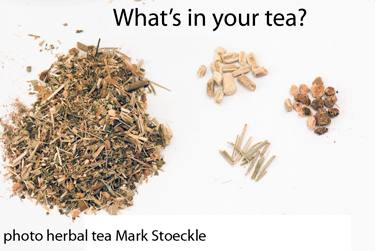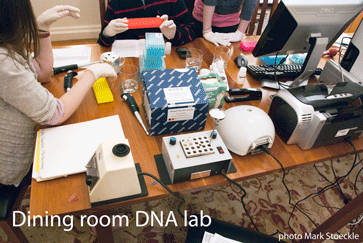What’s in your favorite tea? The dried and sometimes cooked or fermented bits of plants used to make teas are not easily identified to species by appearance. Over the past year I have been involved in a project testing whether DNA barcoding can identify the ingredients in commercial tea products, working with three New York City high school students and plant experts from Tufts University (Selena Ahmed) and The New York Botanical Garden (Damon Little). Student investigators Katie Gamble, Rohan Kirpekar, and Grace Young collected 146 tea products from 25 NYC locations, representing 33 manufacturers, 17 countries, and 82 plant common names–73 products were regular teas (prepared from Camellia sinensis, the tea plant) and 73 were herbal products prepared from other plant species.
 Our findings are published in 21 July 2011 Scientific Reports, (Nature Publishing Group’s open access journal). About 1/3 of herbal teas generated DNA identifications indicating unlisted ingredients including weeds like annual bluegrass (Poa annua) and white goosefoot (Chenopodium album) and herbal plants like chamomile (Matricaria recutita). Matching DNA ingredients to listed ingredients was sometimes challenging–we observe that “broad-scale adoption of plant DNA barcoding may require algorithms that place search results in context of standard plant names and character-based keys for distinguishing closely-related species.”
Our findings are published in 21 July 2011 Scientific Reports, (Nature Publishing Group’s open access journal). About 1/3 of herbal teas generated DNA identifications indicating unlisted ingredients including weeds like annual bluegrass (Poa annua) and white goosefoot (Chenopodium album) and herbal plants like chamomile (Matricaria recutita). Matching DNA ingredients to listed ingredients was sometimes challenging–we observe that “broad-scale adoption of plant DNA barcoding may require algorithms that place search results in context of standard plant names and character-based keys for distinguishing closely-related species.”
 We are pleased that our investigation has attracted press coverage including New York Times print and online editions and internationally in 65 news sites and 14 countries, including India and China, world centers of tea production. Most of the DNA work was done at The New York Botanical Garden in senior author Damon Little’s laboratory. For a small subset of samples (10) we did DNA isolation and amplification in my dining room with recycled lab equipment purchased on the internet for about $5000. Samples were mailed to a commercial facility (Macrogen) for DNA sequencing, with results available by email the next day. It cost about $15 a sample including sequencing (unidirectional). More info and pictures on our TeaBOL website!
We are pleased that our investigation has attracted press coverage including New York Times print and online editions and internationally in 65 news sites and 14 countries, including India and China, world centers of tea production. Most of the DNA work was done at The New York Botanical Garden in senior author Damon Little’s laboratory. For a small subset of samples (10) we did DNA isolation and amplification in my dining room with recycled lab equipment purchased on the internet for about $5000. Samples were mailed to a commercial facility (Macrogen) for DNA sequencing, with results available by email the next day. It cost about $15 a sample including sequencing (unidirectional). More info and pictures on our TeaBOL website!
What’s next? I am excited about enabling wider use of DNA barcoding by high school students, including Cold Spring Harbor’s Urban Barcode Project competition (I am an advisor), open to teams from all New York City schools, with a focus on public institutions. I expect that soon manufacturers of teas and herbal products (and regulators) will incorporate DNA barcode testing into their quality control practices. One of the important tasks for scientists is building up the reference databases. At the time of the study, BOLD (Barcode of Life Database) and GenBank lacked rbcL or matK records for about 1/3 of plant species listed on product labels in our study. More on herbal plant identification: (Lou et al 2010. An integrated web medicinal materials DNA database. BMC Genomics 11, 402; Smillie and Kahn 2010. A comprehensive approach to identifying and authenticating botanical products. Clin Pharm Therapeutics 87, 175).